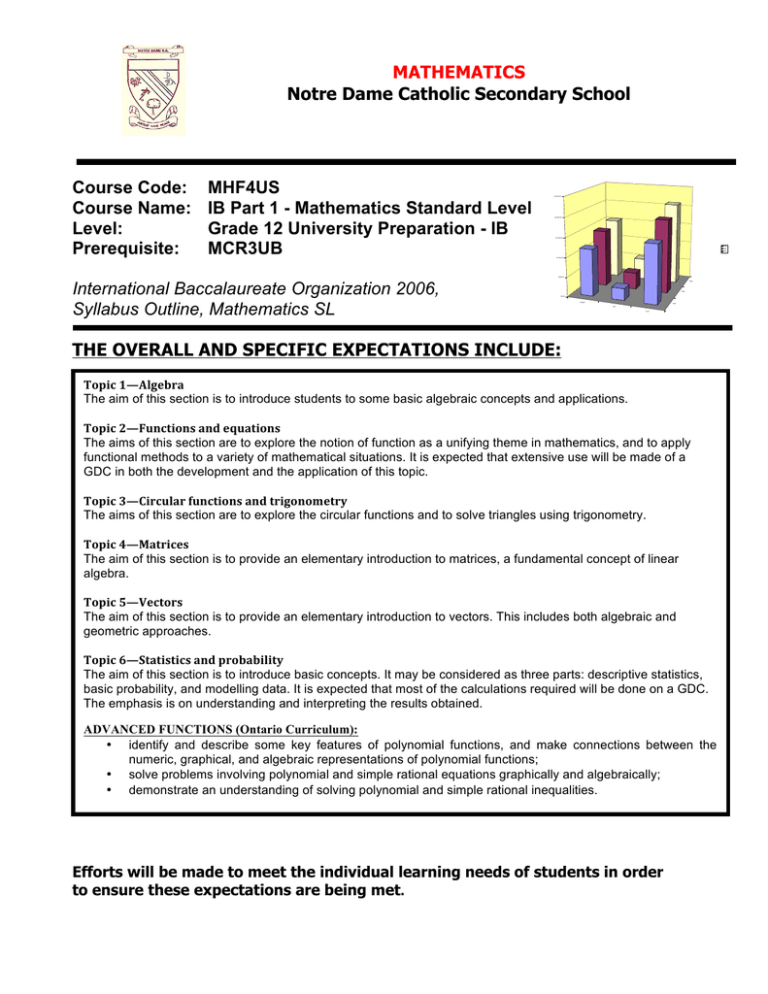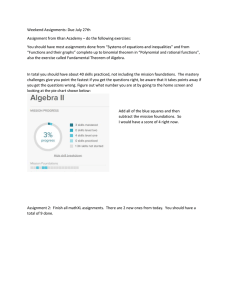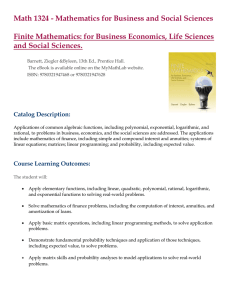Notre Dame Catholic Secondary School Course Code: MHF4US
advertisement

MATHEMATICS Notre Dame Catholic Secondary School Course Code: Course Name: Level: Prerequisite: MHF4US IB Part 1 - Mathematics Standard Level Grade 12 University Preparation - IB MCR3UB $2,500.00 $2,000.00 $1,500.00 1993 1994 1995 $1,000.00 $500.00 International Baccalaureate Organization 2006, Syllabus Outline, Mathematics SL 1995 1994 $0.00 Wages 1993 Tips Total THE OVERALL AND SPECIFIC EXPECTATIONS INCLUDE: Topic 1—Algebra The aim of this section is to introduce students to some basic algebraic concepts and applications. Topic 2—Functions and equations The aims of this section are to explore the notion of function as a unifying theme in mathematics, and to apply functional methods to a variety of mathematical situations. It is expected that extensive use will be made of a GDC in both the development and the application of this topic. Topic 3—Circular functions and trigonometry The aims of this section are to explore the circular functions and to solve triangles using trigonometry. Topic 4—Matrices The aim of this section is to provide an elementary introduction to matrices, a fundamental concept of linear algebra. Topic 5—Vectors The aim of this section is to provide an elementary introduction to vectors. This includes both algebraic and geometric approaches. Topic 6—Statistics and probability The aim of this section is to introduce basic concepts. It may be considered as three parts: descriptive statistics, basic probability, and modelling data. It is expected that most of the calculations required will be done on a GDC. The emphasis is on understanding and interpreting the results obtained. ADVANCED FUNCTIONS (Ontario Curriculum): • identify and describe some key features of polynomial functions, and make connections between the numeric, graphical, and algebraic representations of polynomial functions; problems polynomial simple rational equations graphically and algebraically; Efforts •will solve be made to meet involving the individual learning and needs of students in order to ensure these expectations are being met. • demonstrate an understanding of solving polynomial and simple rational inequalities. Efforts will be made to meet the individual learning needs of students in order to ensure these expectations are being met. Course Breakdown Resources: Unit 1 Unit 2 Unit 3 Unit 4 Unit 5 Unit 6 Unit 7 – Matrices – Vectors – Statistics of One Variable – Permutations and Organized Counting – Combinations and the Binomial Theorem – Probability and the Binomial Distribution – The Binomial Distribution and The Norman Distribution Unit 8 – Polynomial Functions Unit 9 – Polynomial Equations and Inequalities The course will use a variety of resources and a variety of print sources. The textbook, Mathematics SL for the International Student, will be distributed to students during the course. The text and all other resources assigned to students are the responsibility of the student. Any damage incurred will result in payment for replacement. Replacement cost for the text is $100.00. Evaluation Structure:: Knowledge/Understanding Thinking/Inquiry Communication Application 30 % 20% 20 % 30% The above is reflected both in the term work (worth 70% of the final mark) and the summative work (worth 30% of the final mark). Evaluation Policy Students will be assessed & evaluated according to the work produced & skills displayed. Methods of providing feedback will include assessing work in process & evaluating completed assignments, tests, co-operative learning activities, simulations and presentations. Peer & self-evaluations will also be utilized. Student marks will be determined by evaluating process & product according to 4 categories & 4 levels. Please see the chart below for specific skills and key words used to determine student competency in the different categories. Level Category Knowledge/Understanding Knowledge of facts & terms Understanding of concepts & relationships • • Thinking/Inquiry Critical thinking skills Creative thinking skills Inquiry Skills • • • Communication Communication of ideas and information Use of symbols & visuals Oral & written communication • • • Level 1: 50-59% Level 2: 60-69% Level 3: 70-79% Level 4: 80-100% -Limited display of knowledge, skills and ability to apply concepts -Some success in displaying knowledge, skills and application of concepts -Considerable display of knowledge skills and ability to apply concepts -Thorough understanding of concepts and ability to communicate, think creatively and apply concepts Application Applications in familiar contexts Transfer of concepts to new contexts Making logical conclusions and predictions Use of technology Making connections • • • • • Feedback will also be provided for student learning skills. Skills like working independently, team work, organization, work habits and homework, and initiative are assessed independently student achievement and will be conducted through the use of a rubric indicating specific criteria to be achieved to receive each of the following letter grades: E –Excellent G – Good S – Satisfactory N - Needs Improvement Other Evaluation Issues § § § § § LATE ASSIGNMENTS. Assignments submitted after the Primary Due Date established by the teacher will be accepted with a penalty of 5% off for the first day late and 2% for subsequent days to a maximum of 10%. This four day Penalty Zone is the maximum time allowed for submissions. The fourth day after the assignment is due is considered the Closure Date upon which no further assignments will be accepted. If the teacher returns the marked assignments within the four day penalty zone, the date of return is considered the closure date. Repeated lateness in submissions indicates poor organization skills and will result in parental contact and will be reflected in the learning skills section of the report card. INCOMPLETE ASSSIGNMENTS Assignments will be graded according to the extent with which they meet the criteria established in the rubric or evaluation structure. MISSED TESTS Tests missed with a legitimate reason will be written within a few days of the student returning from the absence. Student eligibility to write the test and the date of writing will be at the discretion of the teacher in consultation with the department head. CULMINATING ACTIVITIES These activities will be due toward the end of the course. They are valued between 5 and 15 per cent of the final mark and will reflect course material and competencies not otherwise reflected on the final exam. Plagiarism in any form reflects academic dishonesty and will result in a mark of zero for the assignment in question.



